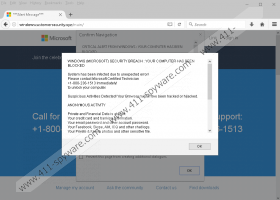+1-800-236-1513 Removal Guide
If you find a warning message popping up in your browser that pushes you to call +1-800-236-1513 for Microsoft certified technical support, you should know that you have been infected with a fake alert. This is indeed a technical support scam that is very similar to “Fake Windows Defender Prevented Malicious Software Tech Support,” “License has Expired +1-888-303-5121,” and “Fake Microsoft Office Activation Tech Support,” which have emerged in the past months. The main idea behind this malware threat is that these crooks try to manipulate unsuspecting computer users into believing that they have no other choice but to call the support hotline number (+1-800-236-1513) and get help. This call, however, could cost you a few hundred dollars since you would be talked into buying a “best deal” service with a great “discount” now or an application with the same fake conditions. Nevertheless, we advise you to pass on this offer and instead, remove +1-800-236-1513 from your computer ASAP.
When this fake alert appears in your browsers, it is possible that you have clicked on unreliable third-party content. This can happen when you are running a web search through a browser hijacker and are exposed to modified search result links or you are visiting a malicious website where you click on any suspicious content. In these ways you can be directly taken to windowscustomersecurity.xyz, which is the malicious page that displays this fake alert. However, apart from being redirected to this page there is another way for you to land there. This would mean though that you have allowed a number of malware infections on board, most likely in a software bundle.
This is rather unfortunate because a bundle can hold several browser hijackers, adware programs, Trojans, fake alerts, and potentially unwanted programs as well. Infecting your computer with such a lot could seriously expose your system to cyber criminals. In order to protect your PC from more harm, you should stay away from questionable websites that host remarkably too many third-party ads. It makes it a bit difficult for you though that some of these ads do not even show up as normal commercials. For example, you can find pages where four download buttons pose for you to choose from, but only one of them belongs to the site. If you click on the fake ones, you may drop a malicious bundle onto your system or redirect your browser to this malicious page. If you want to restore your system, we suggest that you scan your computer with a trustworthy malware scanner after you delete +1-800-236-1513 and all the potentially related malicious programs.
Ending up on this fake alert page, you may really think that something bad happened. In the background, you can see a webpage that looks like an authentic Microsoft Windows warning page. In the foreground, you are presented with pop-up windows informing you about the made-up infection that is claimed to have hit your system. This fake alert also states that your system has been locked and the only way for you to unlock it is for you to call the given telephone number, +1-800-236-1513.
If you click OK on the pop-ups, you may be introduced to a box where you are asked to enter your username and password. This could be used by these schemers to gain access to your system; therefore, we advise you not to provide such data when approached in such a way. You should know that this malware threat is a simple scam to make you call the given number so that worthless services or applications could be sold to you. However, in this process you may share your personally identifiable information with these crooks, which could be sold on the dark web and misused by criminals. Since you can also lose a few hundred dollars, we recommend that you do not hesitate to remove +1-800-236-1513 from your system.
If you have been redirected to this malicious page by clicking on a link or a third-party ad generated by a shady website, it could be enough for you to simply close the browser window. However, if this redirection was made through a malware infection, you also need to clean your system of all possible threats to restore the previous virtual security level. You can try to identify the suspicious programs by scanning through your extensions in your browsers and the list of your installed programs in Control Panel. We have included the necessary instructions for these processes if you need any assistance. Nevertheless, there is no guarantee that you can find all the potential threat sources in these ways. This is why we also suggest that you install a reputable malware removal application as soon as possible so that you can automatically defend your beloved PC.
Remove +1-800-236-1513 from browsers
Google Chrome
- Press Alt+F and choose Settings.
- Scroll down and click Show advanced settings.
- Scroll down and click Reset settings.
- Click Reset in the pop-up.
Mozilla Firefox
- Press Alt+H and select Troubleshooting Information.
- Click Refresh Firefox.
- In the confirmation window, click Refresh Firefox again.
Internet Explorer
- Press Alt+T and go to Internet Options.
- Select the Advanced tab and click Reset.
- Select Delete personal settings and press Reset.
- Click Close.
Remove +1-800-236-1513 from Windows
Windows 8, Windows 8.1, and Windows 10
- Press Win+R and type control panel.
- Select Uninstall a program.
- Click on the suspicious program and press Uninstall.
Windows Vista and Windows 7
- Open the Start menu and choose Control Panel.
- Pick Uninstall a program.
- Click on the suspicious program and press Uninstall.
Windows XP
- Click the Start button and open Control Panel.
- Select Add or Remove Programs.
- Click on the suspicious program and press Remove.
+1-800-236-1513 Screenshots:


